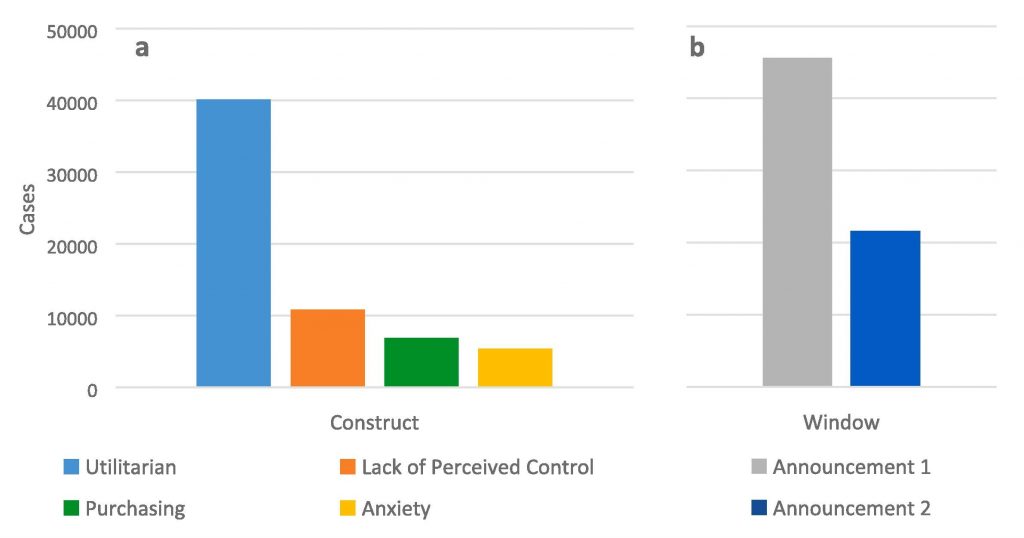Why People Hoarded Toilet Paper at the Beginning of the Pandemic ? May 18, 2021 - Blogs on Text Analytics

A text analytics study of Twitter data using Wordstat 8
We have all heard the stories about people around the world stocking up on utilitarian goods such as toilet paper, soap, disinfectant, and other products at the beginning of the COVID-19 lockdown. News reports showing barren store shelves brought the situation home and created the appearance of shortages. In fact, we have learned that for many products the shortages were temporary. The extra buying was exacerbated by news items and social media reports. The reality is that people were over purchasing, and by doing so they stretched the retail networks just-in-time supply chain. Factories were continuing to produce the same amount of toilet paper as always and once the panic subsided the store shelves returned to normal. But what caused the initial flurry of activity? Why did it abate? What were the factors influencing this behavior?
In their paper Barnes, Diaz, and Arnaboldi (2020) looked to social media for some answers. They studied more than 24,000 Italians’ comments on Twitter to try to understand the motivations and how government announcements impacted them. They collected more than 59,000 tweets over 14 days.
The authors explored compensatory control theory (CCT) which suggests that panic buying is a subconscious solution to a problem.
In effect, CCT suggests panic buying helps individuals feel more in control of an uncertain situation, even if such measures are not required realistically. Under situations of limited control, individuals are able to regulate their feelings of control via alternative means (Thompson, 2009). Thus, choices in consumption behavior may form illusory beliefs of an effect on an individual’s environment (Landau, Kay, & Whitson, 2015). More specifically, CCT builds on existing literature that suggests consumers’ desire to seek structure in their choices and behavior (Hamerman & Johar, 2013; p. 3)
The Twitter data for the study was collected from the Twitter API focusing on the hashtag #iorestoacasa which translates as, I stay at home. The authors built dictionaries using WordStat 8 to measure concepts such as utilitarian, purchasing, lack of perceived control, and anxiety. Utilitarian, purchasing, lack of perceived control concepts dictionaries were built from the ground up. For fear and anxiety, the dictionary LIWC2015 (Pennebaker et al., 2015) was used as the base. The dictionary was then tailored to the data set and extended using the WordNet functionality and dictionary builder in WordStat 8.
The table below from the paper shows some examples.
| Concept | Example Dictionary Items |
| Anxiety (90 words) | afraid, alarm, confused, distraught, frantic, insecure, nervous, panic, scared, tense, terrified, threat, twitchy, uncomfortable, upset, worry. |
| Lack of Perceived Control (206 words) | Defenseless, dependent, helpless, hopeless, impotent, incapable, ineffective, pathetic, powerless, surrender, unable, voiceless, weak. |
| Utilitarian (281 words) | cleaner, domestic, household, functional, packet, practical, pragmatic, prepare, provision, purpose, standard, tinned, useful, utility, vacuum. |
| Purchasing (80 words) | bargain, bought, cart, customer, delivery, discount, mall, outlet, procure, purchased, shopping, store, supermarket, transact, impulse-buy, vendor. |
Table 1. Concept Dictionaries and Examples.
The authors measured these concepts on Twitter, in-line with two government announcements made at different times during the study period. The figure below from the paper shows 77% of cases were during the government announcement 1 window and 36% during the government announcement 2 window. The authors note that the second announcement was more detailed than the first which may be one of the reasons for less activity.

Text analytics study of Twitter data using wordstat about Hoarding Toilet Paper at the beginning of the COVID-19 lockdown
The analysis and findings are very interesting and instructive to academics studying CCT and to retailers and governments both in terms of how to prepare for the early stages of a pandemic type of situation and how best to communicate information to the population.
Barnes, S. J., Diaz, M., & Arnaboldi, M. (2020). Understanding panic buying during COVID-19: A text analytics approach. Expert Systems with Applications, 114360.
